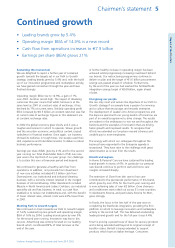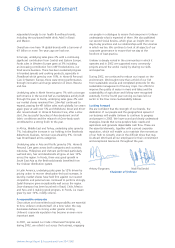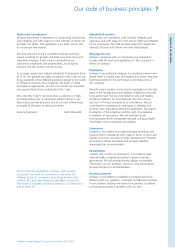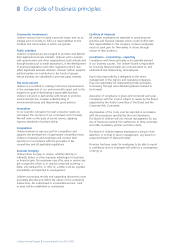Unilever 2002 Annual Report Download - page 18
Download and view the complete annual report
Please find page 18 of the 2002 Unilever annual report below. You can navigate through the pages in the report by either clicking on the pages listed below, or by using the keyword search tool below to find specific information within the annual report.
Unilever Annual Report & Accounts and Form 20-F 2002
Operating review – highlights 15
Report of the Directors
Basis of reporting and discussion
Our accounting policies are based on United Kingdom
generally accepted accounting principles (GAAP) and UK and
Netherlands law which differ in certain respects from United
States GAAP. The principal differences are described on
page 119. We have shown reconciliations to net income and
capital and reserves under US GAAP on pages 118 and 119.
The commentary throughout this operating review is,
unless otherwise indicated, based on the results of the
Group including acquisitions made each year, at constant
rates of exchange (see below) and before exceptional
items and amortisation of goodwill and intangibles (BEIA).
In our reporting, turnover means Group turnover plus our
share of turnover of joint ventures, net of our share of any
sales to the joint ventures already included in the Group
figures. Operating profit means Group operating profit plus
our share of operating profit of joint ventures. These
measures do not include our share of the turnover or
operating profit of associates. References to sales growth
are made on an underlying basis, excluding the effects of
acquisitions and disposals. References to turnover growth
include the effects of acquisitions and disposals.
Reporting currency and exchange rates
Foreign currency amounts for results and cash flows are
translated from underlying local currencies into euros
using annual average exchange rates; balance sheet
amounts are translated at year-end rates except for the
ordinary capital of the two parent companies. These are
translated at the rate prescribed by the Equalisation
Agreement of £1 = Fl. 12, and thence to euros at the
official rate of 1.00 = Fl. 2.20371 (see Control of
Unilever on page 138).
The discussion of performance included in this operating
review is based on constant rates of exchange. This removes
the distorting impact of currency movements and more
clearly portrays the underlying progress of the operations
themselves. The rate used is the annual average rate for the
prior year. For each two-year period, the year-on-year trends
in euros are the same as those which would arise if the
results were shown in sterling or US dollars at constant
exchange rates.
For the reporting of 2000 at current exchange rates, the
results of the Bestfoods business acquired on 4 October of
that year were translated at the average rates of exchange
for the last quarter of 2000. In the constant rate comparisons
for 2001 included in the Operating review on pages 18
to 34, the results for all parts of the Group have been
translated at average rates of exchange for the full year to
31 December 2000. This means that the 2000 results in
these comparative tables will differ in some cases from the
values translated at current rates of exchange.
Details of exchange rates used in preparation of these
accounts and of the Noon Buying Rates against the
US dollar are given on page 117.
2002 results compared with 2001
Including the impact of acquisitions and disposals, turnover
for the year of 52 020 million was in line with 2001 levels.
Excluding the effect of acquisitions and disposals, underlying
growth was 4.2%. The net effect of acquisition and disposal
activity was a reduction of 4.4%.
Operating profit BEIA increased by 6.5% to 7 739 million
and operating margin BEIA moved ahead to 14.9% from
13.9% in 2001. The improvement in margin is primarily due
to business restructuring and procurement savings under the
Path to Growth strategy combined with continued success
in the integration of Bestfoods, partially offset by higher
advertising and promotions expenditure.
Operating profit increased by 3.4% to 5 436 million.
This includes a higher net charge for exceptional items
than the prior year, which included higher profits on the
sale of brands.
Exceptional items
Operating profit for the year includes net exceptional
charges of 939 million, an increase of 59.7% on 2001.
Restructuring investment was 1 298 million, which was
offset by the release of provisions following settlement of
certain legal claims in our favour and profits on disposals
totalling 359 million.
The exceptional items incurred in the year primarily
relate to the Path to Growth strategy we announced
on 22 February 2000 to accelerate growth and expand
margins, and to restructuring arising from the integration
of Bestfoods. The aggregate cost of these programmes over
5 years is estimated to be 6.2 billion, the majority of
which is expected to be exceptional. An 828 million
profit recognised in 2001 on the sale of brands to secure
regulatory approval for the acquisition of Bestfoods is not
included in this estimate.
Details of movements in restructuring and other provisions
are given in note 19 on page 95.
Under US GAAP, some of the restructuring charges in each
year would not have been recognised until certain additional
criteria had been met, and would then have been included
as a charge in subsequent years. Details of the US GAAP
adjustments relating to the restructuring charges are given
on pages 118 to 120.
Amortisation of goodwill and intangibles
The amortisation charge for the year was 1 364 million,
adecrease of 4.1% on 2001. 2002 includes 1 110 million
(2001: 1 170 million) in respect of goodwill recognised on
the acquisition of Bestfoods.
Under US GAAP, there is no amortisation charge with effect
from 1 January 2002 for goodwill or for intangible assets
having indefinite lives. Further details are given on pages
118 to 120.
























